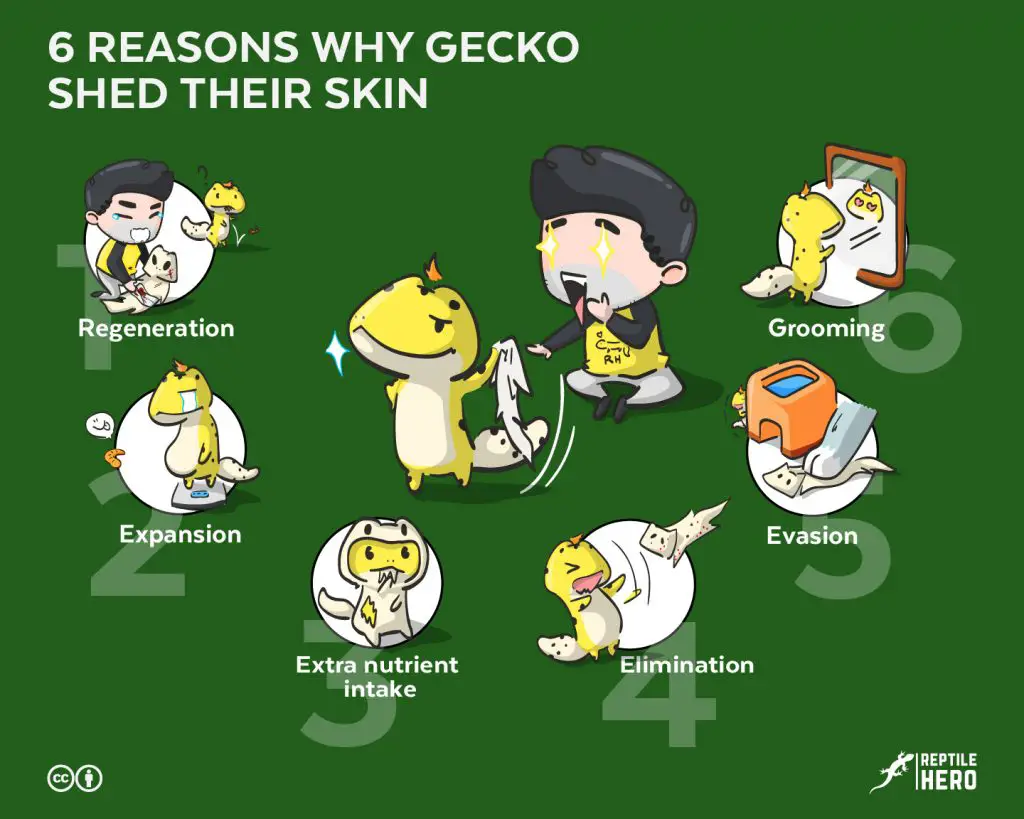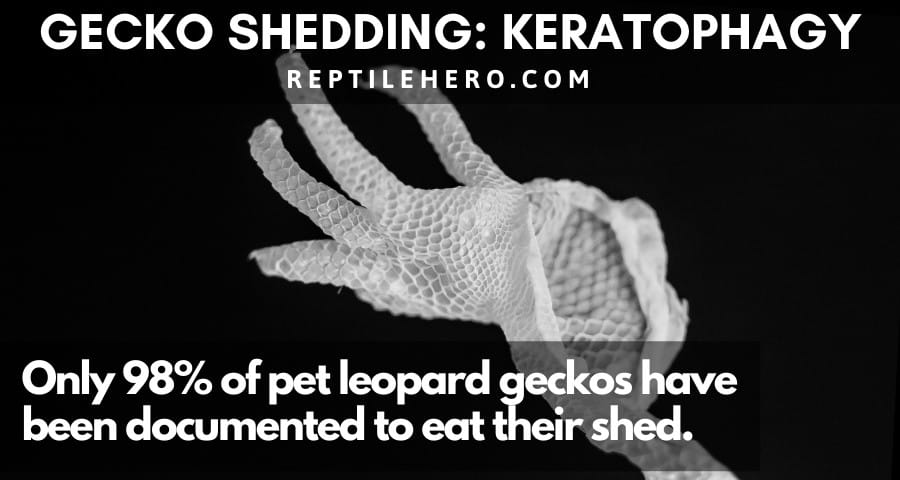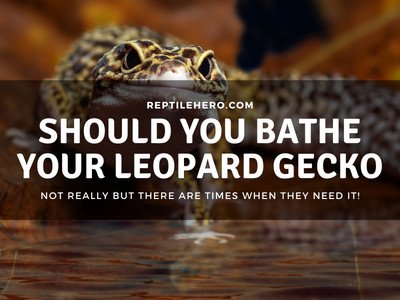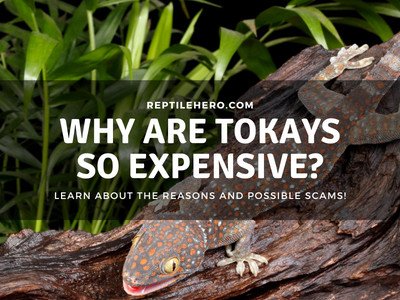Skin Shedding in Geckos (What is It and Why Does It Happen?
Has your gecko gotten ghostly white just in time for Halloween? Well, it’s not something to worry about and your gecko won’t be knocking on your door asking for treats—save the chocolates for the kids. You might have just been lucky to see your gecko shed its skin!
Generally, geckos shed their skin weekly or monthly based on multiple factors like growth, humidity, diet, metabolism, and genetics. Shedding serves numerous biological functions for geckos: regeneration, expansion, reservation, elimination, evasion, and grooming. Also, it is normal for most geckos to eat their shed.
Never seen your gecko eat its shed skin? Don’t worry—some geckos don’t even eat their shed at all. If you’re wondering why your gecko may or may not eat their slough, read on to find out!
The Science of Shedding Skin for Gecko [Get to Know Your Pet’s Biology]
Geckos, like most of their reptile relatives, are known to regularly shed their skin and/or scales. However, it seems that not many beginner gecko keepers fully understand what shedding actually entails.
What Happens When Geckos Shed? (The Process of Ecdysis)
A gecko undergoes three recurrent procedures when it sheds its skin: 1) rest, 2) renewal, and 3) release. Once the third step is complete, the process starts again from the beginning. This regular and cyclical shedding process is more correctly termed as ecdysis.
Shedding is also otherwise referred to as molting or sloughing [1, 2].
Contrary to what some reptile owners think, shedding is not as simple as it seems. It is a biological process that typically costs reptiles a considerable amount of time, effort, and resources.
Reptiles are more vulnerable to infections and parasites while in the midst of sloughing off their old skin completely.
To understand why this is the case, you have to familiarize yourself with the three basic phases of shedding for geckos.
Shedding Step #1—Rest
You need to know that your gecko’s skin, although a bit like ours, is not the exact same thing. It is composed of different layers and sublayers, each one playing a key role in shedding.
During the resting phase of the shedding cycle, a gecko’s outermost skin layer—which we know as the epidermis—consists of three main layers.
A gecko’s outer skin is made of the following layers (from top to bottom):
Stratum corneum: This is the layer you can touch and see directly without needing to dissect a reptile or use a microscope. It is made of the same substance that makes up your nails and hair (the so-called keratin).
Its topmost coating is hard, made of dead skin cells, and is referred to as the Oberhäutchen, or more commonly, the cuticle. This comes into form as scales, spines, crests, horns—basically, any form of protective covering your beloved gecko has.
Stratum granulosum: This is the intermediate layer of the epidermis containing skin cells in various stages of development.
In the middle, there is a thin fat-rich membrane called the mesos layer that separates the upper beta (β) layer from the lower alpha (α) layer. Additionally, this lipid layer plays a role in water loss and retention.
Stratum basale or germinativum: This is the deepest layer of the epidermis which is composed of cube-shaped cells that produce the protective protein, keratin.
Shedding Step #2—Renewal
In the course of the renewal phase of the gecko’s shedding cycle, the stratum germinativum cells (the deepest of the tree skin layers) will duplicate themselves to form newer layers of skin cells. If you still remember your biology classes, you will remember this process called mitosis.
Simultaneously, these newly replicated epidermal layers will continue maturing and move upwards.
Shedding Step #3—Release
After the cell regeneration process is done, the differentiation between the new inner and old outer skin layers will become clear.
Special body fluids (called lymphatic fluids) along with white blood cells and enzymes will be dispersed into the space between the old and new skin. This is the key to a gecko’s successful shedding.
This fluid produced by your gecko facilitates the efficient separation of the two layers (new and old), for better release and removal of the shed skin or outer generation.
It is at the release phase of the shedding cycle where the gecko’s skin notably turns dull and ashy—even on the tongue, lips, eyes, and ears [3]. As a result, their senses of smelling, seeing, and hearing, are temporarily compromised.
The release phase is what we recognize as the actual shedding time of the gecko since we can’t really directly see and observe the rest and renewal phases of the cycle.
Once the old skin is successfully shed, the outermost skin layer (the new Oberhäutchen) will harden as time passes for better protection and decreased permeability. Your gecko will also regain its distinct coloration at this time and its skin can rest again.
How long does it take for a gecko to finish shedding its skin?
A healthy gecko will normally finish shedding its skin in a span of a couple of hours or less—from 15 minutes up to 24 hours. However, the entire release phase of a gecko’s shedding cycle, when it is noticeably dull skinned, may last from 3 to 7 days.
When and How Often Does a Gecko Shed Its Skin?
Generally speaking, a gecko sheds less as it grows older—hatchlings and juveniles can shed weekly, whereas full-grown adult geckos may only shed once a month or once every two months.
A newly hatched gecko completes its first shed when it is only a few days old—normally around 1 to 5. Then, it will shed again after a week. Subsequently, juveniles will start shedding every week or twice a month. Upon reaching full maturity, the adult gecko will shed at least once a month or so.
This is true for most species commonly kept as pets within the reptile-keeping community like leopard geckos (Eublepharis macularius) and crested geckos (Correlophus or Rhacodactylus ciliatus).
However, do keep in mind that the average frequency and length of a gecko’s entire shedding cycle varies greatly among different species [4, 5]. For example:
- 18 days for common house geckos (Hemidactylus frenatus)
- 25 days for tokay geckos (Gekko gecko)
- 40 days for soft-spined geckos (Strophurus williamsi)
Moreover, numerous other internal and external factors have also been observed to significantly affect a gecko’s shedding cycle [6].
Factors that affect the frequency and length of a gecko’s shedding cycle are as follows:
- Food availability
- Humidity
- Temperature
- Contamination
- Parasite load
- Growth rate
- Dietary requirements
- Overall health status
- Metabolism
- Hormone(s)
- Genetics
If any of these are not properly dealt with, your gecko may have trouble shedding. But don’t worry too much—shedding problems can typically be solved with proper husbandry.
Once your gecko gets recurrent problematic sheds despite having updated husbandry, it’s time to get in touch with your vet to make sure your gecko doesn’t have any serious conditions such as stick tail disease.
Do geckos shed more often during certain times of the year?
Experts have noted that shedding frequency increases while its cycle duration decreases from early spring throughout summer. This coincides with the time when young geckos are expected to experience the peak of their growth spurts. The opposite is observed during fall and winter, some even stop shedding altogether.
Where Do Geckos Go to Shed Their Skin? (Do Geckos Hide to Shed?)
Geckos, regardless of their specific natural habitat, seek shelter in secluded and humid crevices when they are about to shed. Doing so makes it easier for geckos to avoid potential predators and remain secure while sloughing off their dead skin.
Even in more arid areas, native terrestrial geckos are able to burrow deep into the substrate of sand and soil to escape the extreme heat and keep themselves moist and hydrated. They may also find refuge in the inner chambers of rock outcroppings.
On the other hand, arboreal geckos living in tropical countries can find such humid microclimates much easier. They can hide away in hollowed tree trunks and stumps, or behind dense walls of foliage.
At times, geckos may also search for shallow bodies of water (e.g, puddles) where they can partially submerge their bodies and better shed their dead skin.
Why Do Geckos Shed Their Skin? (6 Reasons)
Overall, shedding serves six general functions for geckos [1, 5]:
- Regeneration
- Expansion
- Reservation
- Elimination
- Evasion
- Grooming
However, do note that the exact mechanisms (e.g., biological, environmental, social) that bring about shedding across various gecko species are still not clearly understood.
It is possible that shedding serves more—or less—purposes compared to what I have included here at the time of writing.

Shedding Function #1—Skin Regeneration
Considering the natural habitats of wild geckos, they are bound to get injuries while exploring and foraging through rough terrain.
If not for regular shedding, all the cuts and wounds they have sustained would fester and be more susceptible to infections which could easily cost them their lives.
Shedding Function #2—Growth and Expansion
As a gecko ages and gains weight, its skin will need to accommodate—the newly generated looser skin must adequately cover its entire body, accounting for the size increase.
Without the skin expansion brought about by shedding, a growing gecko’s body would be unnecessarily constricted.
Shedding Function #3—Nutritional Reserve
Similar to when geckos lay infertile eggs, geckos who have limited sources of food available will intentionally consume their shed skin to reclaim the vitamins and nutrients in it—which would have otherwise been lost completely.
Shedding Function #4—Ectoparasitic elimination
Wild gecko populations of most species are normally more prone to being infested by mites and ticks (ectoparasites).
By shedding at regular intervals, geckos can eliminate these pesky critters which cling to the outermost layers of their skin.
Shedding Function #5—Predatory Evasion
Just as most gecko drop their tail in order to buy themselves enough time to escape possible danger, some gecko species also shed their skin easily actively upon being grasped by the hand or mouth of predators [7].
Fish-scale geckos (Geckolepis megalepis), are one of these unique species that are able to almost instantaneously shed their large and colorful bony scales—even at the slightest of touch.
Even more impressive, fish-scale geckos can completely regenerate their impressive and somewhat iridescent scales in just a few weeks without any issues whatsoever.
Shedding Function #6—Grooming
Though one of the main methods geckos use to clean themselves is through licking various parts of their bodies (e.g., lips, eyes), geckos also clean themselves up by shedding.
Hence, shedding prevents the growth of fungi, removes slimy/dirty substances, and gets rid of unwanted scents—among many things—which could have been retained on the skin’s epidermal layer if not for its regenerative property.
Is It Normal for Geckos to Eat Their Shed Skin? (Keratopaghy)
More often than not, the great majority of gecko species will normally eat their shed skin, regardless if they are in the wild or kept in captivity. In research and literature, this is called keratophagy, epidermophagy, dermatophagy, or ceratophagia.
Although many reptiles have been reported to engage in keratophagy, scientists consider the act of eating one’s shed skin, as well as that of other geckos of the same species (conspecifics), as being particularly widespread in geckos [3, 5, 8].
Below are some commonly kept gecko species that are known to eat their shed skin:
- Leopard geckos (Eublepharis macularius)
- African fat-tailed geckos (Hemitheconyx caudicinctus)
- Crested geckos (Correlophus or Rhacodactylus ciliatus)
- Gargoyle geckos (Rhacodactylus auriculatus)
- Gold dust day geckos (Phelsuma laticauda)
- Tokay geckos (Gekko gecko)
Because of this shed-eating habit of theirs, some gecko pet parents will never be able to see their pets while they are shedding—unless they have a camera in their gecko’s tank.
However, not all geckos intentionally eat their shed skin on a regular basis. Case in point: only 98% of pet leos have been documented to actively eat their shed skin [8].

There are also gecko species that have never eaten their shed skin—neither in the wild or in captivity [9]. Such species include the marbled velvet geckos (Oedura marmorata) and the southern spotted velvet gecko (Oedura tryoni).
7 Reasons Why Geckos Eat Their Shed Skin (According to Experts)
As weird as it may seem to us humans, eating its shed skin may play numerous crucial roles to keep a gecko fit and healthy. So if you see your baby gecko chomping down on sough, just let it.
Scientists have put forth seven hypotheses to help explain why geckos eat their shed skin intentionally and unintentionally [3, 8, 9]:
- Nutritional value
- Sensitivity trigger
- Prompted consumption
- Cue detection
- Artificial predation
- Predator avoidance
- Load reduction
These hypotheses may be closely related to the six functions of shedding as well.
Shed-Eating Reason #1—Nutritional Value
Considering the fact that a newly hatched gecko’s first meal outside of the shell is its shed (aside from leftover yolk), it is easy to see why experts believe that the slough has considerable nutritional value.
Shed skin can sustain a hatchling gecko for a few days—2 to 5 days to be exact. It will only start eating small insects, fruits, nectar, and so on, after that.
Unfortunately, we have yet to see studies on the exact nutritional value of a gecko’s shed. Some researchers believe that slough is rich in protein, others argue that it’s more likely full of protein since the skin is primarily made of keratin.
Shed-Eating Reason #2—Sensitivity Trigger
There is also a theory which states that geckos may just be eating shed skin as an instinctual response to the mere presence of slough flakes in the gecko’s mouth.
More importantly, keratophagy as a triggered response is distinctly attributed to the presumed skin sensitivity certain gecko species experience during shedding.
White-spotted wall geckos (Tarentola annularis), for instance, shed their skin in a markedly slow and deliberate manner. In the process of tearing off their slough with their mouths, the pieces of shed skin are ingested instinctively.
Shed-Eating Reason #3—Prompted Consumption
Geckos may also intentionally eat their shed skin not because they want to but because it is the only means of effectively removing pieces of the slough that have been wedged in between their teeth.
However, there are not many studies available—at least to me—to support this notion.
Shed-Eating Reason #4—Cue Detection
Geckos have heightened senses. They have great vision, hearing, and smell, making them highly efficient hunters and foragers.
So if the chemical cues of a gecko’s prey have rubbed off on shed skin—be it the gecko’s own or another—they will be compelled to eat it.
Shed-Eating Reason #5—Artificial Predation
As some experts also point out, carnivorous—and cannibalistic—geckos may be more likely to eat their shed skin or that of others due to them being natural predators of much smaller gecko species.
In the wild, the shed skin of a gecko’s potential prey may serve as an additional source of food and chemical cues that may help with locating it.
The act of eating its shed skin, as well as that of other geckos, could therefore be induced by the gecko’s natural predatory drive.
Shed-Eating Reason #6—Predator Avoidance
As I have already mentioned earlier, the act of shedding and the subsequent act of eating the shed skin could simply be credited to a gecko’s innate tendency towards self-preservation—it’s a survival instinct.
If a gecko can detect possible prey with leftover shed, then a gecko’s potential predators are undoubtedly equally capable of doing so.
Shed-Eating Reason #7—Load Reduction
One of the most common attempts at explaining the reason why geckos eat their shed skin seem to involve load reduction. By load here, I am referring to a gecko’s external parasitic load.
Unfortunately, shedding does not permanently eliminate the problem of mite and tick infestation in geckos unless its environment no longer has such ectoparasites whatsoever.
What are the Common Signs of Shedding in Geckos?
Listed below are the commonly observed signs which indicate that a gecko is about to shed [1, 6]:
- Paling of coloration. Geckos undergo a superficial dulling of their natural base color and patterns as their shedding cycle progresses. For darker gecko morphs, instead of taking on a whiter or grayer appearance, their skin may appear to have a blue tinge.
- Sticking problems. If your pet gecko has setae on its toe pads, you can expect it to have trouble walking and clinging onto vertical surfaces before it sheds. The unshed skin that is yet to be sloughed off interferes with the setae, making it not as sticky.
- Milky/cloudy eyes. The eyes of geckos may become increasingly cloudy as they go through the shedding cycles. As a result, their vision may be blurry, if not completely lost during that time.
- Reduced activity. Successful shedding takes a good deal of time and effort for geckos. So instead of actively exploring and foraging like they normally would, shedding geckos will focus on getting the dead skin off their bodies.
- Increased hiding. Due to the increased dangers a gecko may face during shedding, they will spend less time out in the open. They will seek moist shelters away from their predators’ reach.
- Heightened vigilance. Probably due to their survival instincts, shedding geckos become more wary and even aggressive. This seems to be especially true when they are constantly handled while still shedding—stress doesn’t mix well with ecdysis.
- Loss of appetite. Your gecko may eat less than usual when it is about to shed—others stop eating altogether for a day or two just before they finally finish shedding. Others have also shared that their geckos become quite picky eaters during this time.
- Wrinkled/loose skin. As your gecko is about to finally get rid of the dead layer of skin covering its body, the said layer will become wrinkled and loose. This helps them easily shed without damaging their new skin that has yet to harden up.
Some geckos may exhibit all of these, whereas others might only show one or none at all—making it difficult to track and observe a gecko’s shedding cycle.
Further Questions
What is a healthy gecko’s shed supposed to be like?
A happy and healthy gecko’s shed is pliable, soft, and velvety to the touch. It will be colorless and translucent but the pattern of your gecko’s scales/skin will still be discernible on it. Conversely, sick/stressed geckos have dry, rough, and leathery sheds.
Why is the shed skin of geckos and snakes colorless?
The shed skin of geckos and snakes is colorless because the pigment-bearing cells (chromatophores) that give their skin the bold and rich colors we are familiar with are located not in the epidermis layer—which is regularly shed—but in the dermis layer beneath it.
Do geckos shed their skin in one piece or multiple pieces?
More often than not, the average gecko will shed its skin in big pieces—sectioned off into the head, arms, upper body, hind legs, and so on. But geckos and other reptiles with particularly elongated bodies may also shed their skin in a single piece. Different owners have documented both cases in captive geckos.
Is it normal for geckos to have an irregular shedding cycle?
Researchers have found that some wild geckos indeed have naturally irregular shedding cycles. However, it is advisable to take a detailed note of a gecko’s shedding cycle and consult an experienced veterinarian to determine whether or not this is normal or healthy.
Can I feed my shedding gecko?
Yes, shedding geckos can still be fed and offered live insects. Keep in mind, however, that it may eat less during this time. This change in appetite is completely normal and not a cause for concern.
What makes a gecko’s nose red while shedding?
If geckos are kept in tanks that are too dry, not given a humid hide, stressed, or sick, they can easily experience abnormal shedding (dysecdysis). To solve this, geckos may resort to excessively rubbing their noses onto abrasive surfaces which results in its reddening and injuries.
Takeaways
During a gecko’s shedding cycle, it experiences three general phases of ecdysis: rest, renewal, and release.
On average, hatchling geckos will shed weekly, juveniles will shed every other week, and adults will shed once a month at most.
All geckos—both wild and captive—seek refuge in hidden, secure, and moist spaces when they are shedding.
Shedding has six purposes in a gecko’s life: regeneration, expansion, reservation, elimination, evasion, and grooming.
Most geckos eat their shed skin (keratophagy) regularly, if not all the time. But some gecko species have never been observed to intentionally eat their slough.
Scientists have proposed seven theories to explain why geckos eat shed skin: nutritional value, sensitivity trigger, prompted consumption, cue detection, artificial predation, predator avoidance, and load reduction.
Paling of skin, sticking issues, cloudy eyes, inactivity, hiding, aggression, loss of appetite, and loose skin are all signs that a gecko is about to shed.
Sources
[1] https://www.intechopen.com/chapters/65535
[2] https://onlinelibrary.wiley.com/doi/abs/10.1002/9781118977705.ch2
[3] https://www.americanhumane.org/app/uploads/2016/08/op-guide-reptilecare.pdf
[4] https://www.jstor.org/stable/1563546
[7] https://www.sciencedaily.com/releases/2017/02/170207092733.htm

![Does Your Gecko Remember You? [2 Owners’ Stories and Science]](https://www.reptilehero.com/wp-content/uploads/2021/06/Does-your-gecko-remember-you-infographic-768x614.jpg)
![3 Reasons Why Your Gecko Smells Bad [and 7 Tips]](https://www.reptilehero.com/wp-content/uploads/2021/04/G34_2-1-768x614.jpg)
![Why Does Your Gecko Feel So Cold? [6 Potential Problems]](https://www.reptilehero.com/wp-content/uploads/2021/02/G43-768x614.jpg)
![The 5 Reasons Why Do Your Geckos Jump [and 5 Precautions]](https://www.reptilehero.com/wp-content/uploads/2022/01/why-geckos-jump-cc-768x614.jpg)


